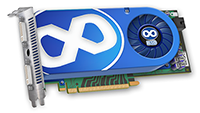OpenGL 3.0 is here (finally)
 Monday 11th August 2008, 10:21:00 PM, written by Richard Connery
Monday 11th August 2008, 10:21:00 PM, written by Richard Connery
Nearly a year since the expected release of the OpenGL 3.0 specifications, the Khronos group has finally unveiled them. The press release mentioned some of the new features:
Vertex Array Objects to encapsulate vertex array state for easier programming and increased throughput;
non-blocking access to Vertex Buffer Objects with the ability to update and flush a sub-range for enhanced performance;
full framebuffer object functionality including multi-sample buffers, blitting to and from framebuffer objects, rendering to one and two-channel data, and flexible mixing of buffer sizes and formats when rendering to a framebuffer object;
32-bit floating-point textures and render buffers for increased precision and dynamic range in visual and computational operations;
conditional rendering based on occlusion queries for increased performance;
compact half-float vertex and pixel data to save memory and bandwidth;
transform feedback to capture geometry data after vertex transformations into a buffer object to drive additional compute and rendering passes;
four new texture compression schemes for one and two channel textures providing a factor of 2-to-1 storage savings over uncompressed data;
rendering and blending into sRGB framebuffers to enable faithful color reproduction for OpenGL applications without adjusting the monitor's gamma correction;
texture arrays to provide efficient indexed access into a set of textures;
32-bit floating-point depth buffer support.The new version of the OpenGL Shading Language, GLSL 1.30, provides front-to-back native integer operations including full integer-based texturing, integer input and outputs for vertex and fragment shaders and a full set of integer bitwise operators. It also improves compatibility with OpenGL ES, adds new interpolation modes, includes new forms of explicit control over texturing operations, provides additional built-in functions for manipulating floating-point numbers and introduces switch statements for enhanced flow control within shader programs.
The full specs are now available online.
Tagging
Related graphics News
Travelling in Style: Beyond3D's C++ AMP contest
Beyond Programmable Shading CS448s first slides available
Khronos release OpenGL 3.3 and 4.0
Mazatech release AmanithVG 4.0, supporting OpenVG 1.1
[Analysis] TSMC 40G to deliver up to 3.76x the perf/mm^2 of 65G & Power Implications
Old News: AMD CTO resigns, NVIDIA CFO retires, DDR3 for MCP7A, S3, etc.
SwiftShader 2.0: A DX9 Software Rasterizer that runs Crysis
S3 launches DirectX 10.1 Chrome 400 GPUs
GPGPU and 3D luminaries join 3D graphics heavyweights
